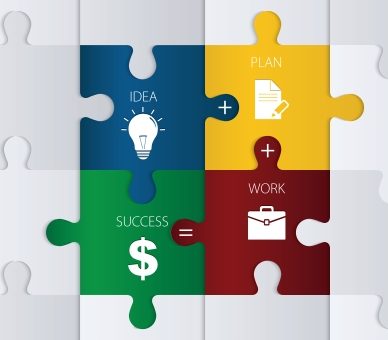The current period of tightening budgets and delayed development gives companies a perfect opportunity to implement an integrated approach to intellectual property and strategic design to focus protection and increase the value derived from IP in the near term, as business moves toward a new-normal.
 The last decade brought unprecedented growth to the U.S. economy. Even through the downturn of the Great Recession, there was rapid development in several important emerging areas, such as connected devices, green technology, health care, and content delivery. These developments helped, in large part, to fuel the historic growth that followed the economic recovery. As growth continued, many companies operating within those once-emergent areas fell into rapid, cyclical development of product after product based on refreshes and incremental improvements to those products. This development cycle allowed companies to extract additional value from the core technology developed earlier in the decade but sacrificed further pursuit of new developments. As a result, the end of the last decade felt fast-paced yet stagnant, with constant new products that merely extended existing categories but largely failed to recreate prior excitement levels or meet any real consumer need. Even companies that tried to continue innovative efforts were forced to dramatically accelerate development to keep up with escalating consumer expectations and to ensure constant profits in a stock market surge where investors would tolerate nothing less.
The last decade brought unprecedented growth to the U.S. economy. Even through the downturn of the Great Recession, there was rapid development in several important emerging areas, such as connected devices, green technology, health care, and content delivery. These developments helped, in large part, to fuel the historic growth that followed the economic recovery. As growth continued, many companies operating within those once-emergent areas fell into rapid, cyclical development of product after product based on refreshes and incremental improvements to those products. This development cycle allowed companies to extract additional value from the core technology developed earlier in the decade but sacrificed further pursuit of new developments. As a result, the end of the last decade felt fast-paced yet stagnant, with constant new products that merely extended existing categories but largely failed to recreate prior excitement levels or meet any real consumer need. Even companies that tried to continue innovative efforts were forced to dramatically accelerate development to keep up with escalating consumer expectations and to ensure constant profits in a stock market surge where investors would tolerate nothing less.
Shifting Patent Strategies
From an intellectual property standpoint, the shift from core development to extraction created a difficult situation. Companies recalled the impact that good protection for groundbreaking products and underlying technology can have on business. Recognizing that seemingly small insights or developments can fuel larger innovation, companies became reluctant to forego patent filings for any idea at any stage of development. The competitive product landscape meant that no feature, detail, or incremental development was too small to cover with a patent filing. On the other hand, the market-driven need to constantly maximize profit meant that all of the increased patent filings had to be completed within shrinking budgets. As a result, patent applications began to become commoditized, with many companies acquiring a great number of patents of diminished quality and questionable strategic value.
The current novel coronavirus pandemic and the resulting economic fallout, however, may provide a good opportunity to step back and reevaluate the way companies approach intellectual property. Many are already broadly reorganizing workflows for collaborative development to deal with distanced or remote working. This may provide an opportunity to reassess where IP fits within these workflows and to find opportunities for greater collaboration. The slowed—or, for some, halted—economy has also lengthened or delayed development cycles, which may give the time needed to discover new ways of strategically managing patent filings. Even those companies seeing less drastic economic effects may observe market trends toward new products or even new categories that fall outside of previous forecasting and planning, inviting more focus and less-compressed schedules.
IP By Design
For certain organizations, effective IP realignment may not require a complete rethinking of how to use and evaluate IP. In a realization that adoption of “design thinking” needed to be accompanied by actual design work, a number of organizations worked in the latter half of the last decade to become more “design centric”. Doing so revolved around aligning other corporate functions with design and making design a key driver of corporate decision-making. Any possible alignment between design and legal work, particularly within the area of IP, was mostly overlooked in these efforts, but can have significant mutual benefits.
Companies that have already integrated strategic design into their corporate development process and employ designers in key roles can, and should, make a similar adjustment to their IP strategy using these design-centric principles. This adjustment involves implementing a framework for addressing patent matters from within—not merely alongside—design work and requires an in-depth understanding of the design process and the way that design work progresses through the various steps of that process. Using that understanding, companies can deliver patent-related information and guidance to a design team based on what is specifically needed at a given point within the design process. Notably, this information is not limited to design patents or considerations of aesthetic appearance, as it has been shown that designers tend to be named on more patents, overall—both utility and design—than non-designers. As a result, companies are in a better position to determine which features, details, or incremental developments are actually important enough for patent protection and can actually leverage IP work to help drive larger innovations.
Seamless Integration
In one specific implementation, a process for integrating patents and design can revolve around the use of a patent-integration specialist as a member or extension of an in-place design team. This individual or group can help the larger design team consider patent research as a component of overall design research and evaluation by participating in ideation or other divergent thinking exercises using knowledge and insight from patent research. A patent-integration specialist can also track, collect, and prioritize ideas and designs for additional searching and application filing at a time that balances cost, concept readiness, and competitive timing requirements. With a specialist in place who understands both the patent side and the design side, the integration process can be worked into existing workflows on a per-project basis, as the specifics of a particular project call for it. This allows for the use of this process to be quickly implemented, without requiring an overhaul of personnel or a company’s overall approach to IP.
In any form, an effectively implemented patent-integrated design strategy strives to have patent issues considered as a matter of course, within and alongside existing design work, without interrupting the progress and creative flow of design. It also works to leverage design insight to help prioritize patent filings and inform strategies for timing and budget. By considering patents along with other criteria, such as user preference, manufacturability, and cost, patent roadblocks can be uncovered early and dealt with appropriately, without causing huge disruptions in a given development plan. An individual or team with the right basis of design knowledge can leverage parallel design considerations to guide the design team away from patent problems toward other promising areas or can indicate where effort should be used to work around or resolve patent issues directly, all without disrupting the design process.
Using this type of strategy helps design to produce even more innovative solutions with a clearer path to implementation along more predictable timetables. This means that, in the short term, a return on investment can be realized almost immediately by the numerous benefits the process adds to the design process. This contrasts with typical IP work, which offers more speculative benefits that are only truly measurable years down the road, if at all. Of course, a patent-integrated design process has long-term benefits, as well. In particular, broader adoption of such a strategy can enhance the effective use of design as an organizational tool for managing uncertainty and can help increase or restore patent value.
It’s a Good Time to Reprioritize
Implementing new processes can be difficult, especially when systems are in place to organize information and activity in a certain way. Times of hardship, however, are natural opportunities to evaluate existing processes and reprioritize actions that can help a company endure downturns while being ready to respond quickly upon a subsequent recovery. Design and product development are undoubtedly critical in efforts to offer new products when consumers are ready to spend and to react to changing needs and emerging product categories. Because it can be disastrous to let such innovations go unprotected, companies should instead look to leverage design insights to help manage their use of IP resources and budgets. A patent-integrated design strategy can help to do this, while also using IP expenditures to benefit the design and development processes, giving companies a distinct advantage in charting a path to emergence from the challenges we all now face.
Image Source: Deposit Photos
Author: Nikolamirejovska
Image ID: 45979527

![[IPWatchdog Logo]](https://ipwatchdog.com/wp-content/themes/IPWatchdog%20-%202023/assets/images/temp/logo-small@2x.png)

![[Advertisement]](https://ipwatchdog.com/wp-content/uploads/2024/04/UnitedLex-May-2-2024-sidebar-700x500-1.jpg)
![[Advertisement]](https://ipwatchdog.com/wp-content/uploads/2024/04/Artificial-Intelligence-2024-REPLAY-sidebar-700x500-corrected.jpg)
![[Advertisement]](https://ipwatchdog.com/wp-content/uploads/2024/04/Patent-Litigation-Masters-2024-sidebar-700x500-1.jpg)

![[Advertisement]](https://ipwatchdog.com/wp-content/uploads/2021/12/WEBINAR-336-x-280-px.png)
![[Advertisement]](https://ipwatchdog.com/wp-content/uploads/2021/12/2021-Patent-Practice-on-Demand-recorded-Feb-2021-336-x-280.jpg)
![[Advertisement]](https://ipwatchdog.com/wp-content/uploads/2021/12/Ad-4-The-Invent-Patent-System™.png)






Join the Discussion
3 comments so far.
Erik T Hall
September 12, 2020 09:10 amThis is quite insightful. From the lens of an inventor opposed to a large budget corporation or attorney this is a fundamental shift on how a startup doing high tech high growth can, and maybe should, approach thier product. It’s one way to develop a patent off of a product, but it makes logical sense to integrate the protection aspect in the design; both mechanical and ornamental. In the long run this approach could position the patent in a more cohesive defensible light. Thank you for your insight.
Mark Nowotarski
September 12, 2020 08:19 amIn my experience, economies adapt to change through the foundation of new companies with new ideas for new products. As I hear from other patent and legal practitioners that specialize in startup clients, we’ve never been busier.
Necessity is the mother of invention. There is an enormous amount of inventing going on right now driven by the need to rapidly adapt to an ever changing world.
MaxDrei
September 10, 2020 09:30 amThe hook of the title worked with me. I read the article hoping for new insights. But I found none. Corporate patent strategy is under review all the time, or ought to be, regardless of any virus. How much budget to allocate to FTO, and how much attention to give to drafting “Quality”, for example, depends on how “patent friendly” are the courts and how “litigation-averse” the competitors in one’s industry segment are. So, if for example the fiercest competition is increasingly Asian-owned, one needs to tune the corporate patent strategy to that reality, rather than to a temporary problem with a virus mutation. In Asia, litigation is seen as failure. Perhaps that’s why, increasingly, drafting quality is not seen as important, sheer quantity of patent grant certificates counting for much more. Will that always be ever more the case? I doubt it.